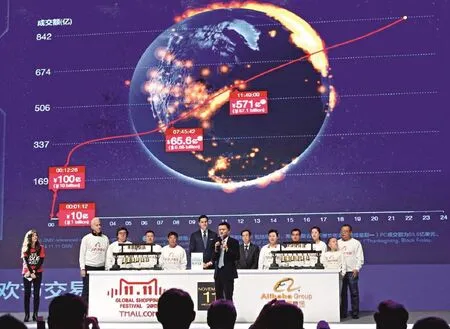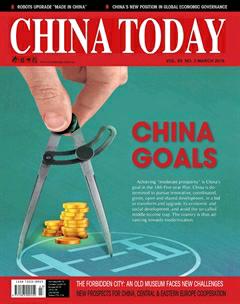China’s Economy in 2016: Slowdown but Higher Quality
By YOU SHANSHAN
China’s Economy in 2016: Slowdown but Higher Quality
By YOU SHANSHAN
THE global economy, as pointed out by International Monetary Fund (IMF) Managing Director Christine Lagarde, is deteriorating to a “new mediocre.” Lagarde’s comment comes at a time when the economies of major countries in the world are becoming characterized by timid recovery, low growth, high unemployment, and high risks.

Jack Ma, executive chairman of Alibaba Group, Daniel Zhang, CEO of Alibaba, and Tom Farley, president of the New York Stock Exchange (NYSE) remotely ring on November 11, 2015 the NYSE Opening Bell at the Water Cube, or National Aquatics Center, in Beijing to celebrate Alibaba’s 11.11 single’s day online shopping fest.
In such an economic environment, China cannot remain unscathed by the impact. In 2015, China’s economy, which entered a “new normal” stage, faced multiple challenges. From a macro perspective, the growth slumps and local governments’ revenue and expenditure were far from optimistic. From a micro perspective, the traditional industrial enterprises failed to achieve any improvement in terms of business but still faced prolonged pressure. The real economy, represented by the real estate sector, faced tough challenges in reducing stock.
Li Yang, well-known economist and former vice president of the Chinese Academy of Social Sciences (CASS), said the Chinese government was promoting an all-round reform, and the world had entered a competitive stage of reforms. China, which has the deepest understanding of the urgency to reform and rolls out the most complete measures, is taking the initiative in the race for global competition in the fu-ture. Undoubtedly, China is at the forefront in this regard.
Mixed Feelings: Reviewing the 2015 Economy
The financial crisis that took hold in 2007 gripped the world for eight years till 2015, with no fundamental improvement of the overall situation. At a news conference held by CASS on December 16, 2015, during which a blue paper on China’s economy in 2016 was released, Li Yang said that the performance of the global economy was far from ideal. Although many countries have adopted various measures, the crisis has not been eliminated. Therefore, various institutions around the world predicted that economic growth in 2015 was likely to hit the lowest point since the crisis broke out. What should be noted is that the economic growth of emerging markets, their trade growth in particular, has gradually lost traction. Previously, the world placed high hopes on developing countries and emerging economies to boost global economic growth. But only China and India have achieved a relatively high growth, which is still a lot lower than their previous levels. This bodes ill for the world economy.
“All these factors bring uncertainties to the recovery of the world economy, due to improper deployment and differences in China’s old and new growth engines in terms of time, space, and force. They make it increasingly difficult to coordinate and balance policies to stabilize growth and cut excess capacity,” said Li.
The blue paper predicts that China’s economic growth in 2015 will have been about seven percent, with the pressure of economic slowdown on the rise. Li Xuesong, deputy director at the Institute of Quantitative & Technical Economics, CASS, analyzed that there were three major reasons that led to the slower growth of China’s economy.
First, China is facing the gradual disappearance of its demographic dividend, a substantial fall in the growth of capital investment, and slow advancement of technology. These factors could lead to a possible further slowdown of China’s economic growth.
Second, the proportion of China’s manufacturing in its GDP is approaching saturation. Manpower and resources are moving towards the tertiary industry, which is represented by the service industry. When more and more manpower and resources switch from manufacturing to the service industry, which has relatively low labor productivity, the overall labor productivity of the Chinese economy is sure to decrease, resulting in an economic growth slowdown.
Third, China’s innovation capability is not strong enough to support economic growth. For example, China ranked first in the world for patent filing in 2014; however, its patent enforcement rate only ranked at a medium level. Efforts must be made to transform innovated technology into products and real productive forces, to create new growth points.
Li Xuesong also pointed out that China’s economic growth in 2015 is predicted to have slowed down to seven percent; however, the trend of accelerating structural reform is becoming increasingly obvious and the new dynamism for economic growth will continue to accumulate.
The industrial structure continues to be optimized. In 2015 the growth rate of the tertiary industry was faster than that of the secondary industry. The proportion of the tertiary industry in GDP has increased for five consecutive years to hit 49.3 percent. According to the blue paper, it is estimated that consumption in 2015 contributed 60 percent of the GDP, hitting a record high since 2012.
Economy Operates Within a Reasonable Range in 2016
“In light of the economic growth in 2015, we predict that growth in 2016 will continue to decrease, but within a reasonable range, with unemployment and the price of commodities staying at a stable level. China’s economy will not experience a hard landing,” said Li Yang.
The blue paper predicts that China’s economy in 2016 will see a growth rate of 6.6 to 6.8 percent. The reasons behind the estimation are as follows: First, China’s economy is entering a “new normal” stage, with a structural adjustment accelerating and potential growth rate leaning towards a decrease. Second, external demand remains weak. The investment base in China is already huge; therefore, the growth rate of investment will return to a normal level. Consumption will maintain stable. Third, the Chinese government will make its proactive fiscal policies more forceful and its prudent monetary policy more flexible and forward-looking. Under the effects of these conditions and factors, it is possible, but still not easy, for China to achieve a quality growth ranging from 6.6 to 6.8 percent in 2016.
Li Yang suggests that it is necessary to enhance the implementation of proactive fiscal policies, whose direct effect on expanding demand should be strengthened. Also the government should moderately increase investment, casting financial funds in a leading role to boost investment in infrastructure construction and other private investment. The government should continue to implement a monetary policy that strikes a proper balance between tight and loose, promoting financial reforms that are conducive to the development of real economy and structural adjustment, thus to establish a healthy capital market and optimize financial resources allocation.
The year 2016 is the first year of China’s 13th Five-Year Plan. While moderately expanding the demand and focusing on such areas as cutting industrial overcapacity, lowering costs, reducing stock, and preventing risks, the Chinese government should strengthen structural reform on the supply side to increase the quality and efficiency of the supply system and provide a growth impetus for sustainable economic development, in a bid to achieve a good start for the 13th Five-Year Plan.
YOU SHANSHAN is a reporter with China Pictorial.

